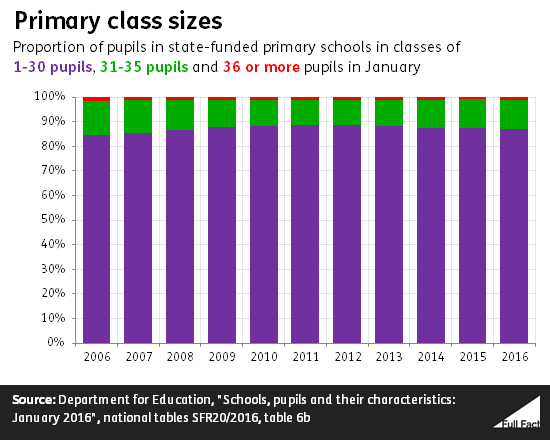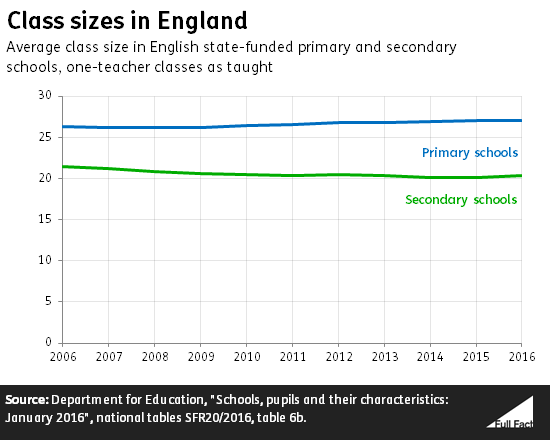If you think classes of over 30 qualify as being “crammed into classrooms like sardines” then it’s true that hundreds of thousands of children were in that situation last year. 30 pupils to one teacher is the legal limit (with some exceptions) for infant classes, which are for the very youngest pupils.
Around 540,000 primary school pupils in English state-funded schools were in classes with 31 or more pupils in January 2016, as were about 300,000 secondary school pupils.
This isn’t anything new. Those numbers have been in the hundreds of thousands ever since 2006—as far back as the statistics go.
The proportion of pupils in classes of 31 or more has risen in primary schools over the past four years, from 11.4% of pupils in 2012 to 12.9% in 2016. Up until 2011 it had been falling, from a peak of 15.2% in 2006.
In secondary schools, there’s less of a clear trend. The proportion has fluctuated since 2006. It’s very slightly up on the level in 2010—from 10.2% of pupils in 2010, to 10.3% in 2016.
Primary schools have been facing greater pressures on school places, with the total number of primary age children rising since 2008. In secondary schools, the total number has been falling since 2006, but has started to rise in the past year.
Mr Corbyn is correct that around 40,000 pupils were in classes of 36 or more in state-funded primary schools in England in 2016.
That’s around 1% of all pupils in primary schools. The proportion has remained at roughly this level over the last 10 years.
The average size of primary school classes in England has been slowly increasing. There were 27.1 pupils in the average class in 2016 compared to 26.3 in 2006.
It is correct that in Wales the number of infants in large classes has increased by 18% since 2013.
That’s an increase of just over 1,200 pupils to around 8,200 (or about 8% of all infant pupils in primary and middle schools).
A large class is counted as any with 31 pupils or more in it and an infant class is any class in Reception, Year One or Year Two. So this isn’t looking at the same thing: the Labour party was looking at primary school pupils of all ages, in classes of 36 or more.
It’s possible to get a more like-for-like comparison by looking at the number of infant pupils in large classes in England.
Over the same time period the number of pupils in infant classes of 31 or more in England increased by 32%. This meant an increase from 72,000 pupils to around 95,000 or around 6% of all infant classes.

